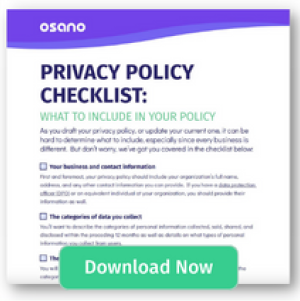
How Osano Does DSARs
Subject rights requests can be confusing for everybody involved.
Read NowGet an overview of the simple, all-in-one data privacy platform
Manage consent for data privacy laws in 50+ countries
Streamline and automate the DSAR workflow
Efficiently manage assessment workflows using custom or pre-built templates
Streamline consent, utilize non-cookie data, and enhance customer trust
Automate and visualize data store discovery and classification
Ensure your customers’ data is in good hands
Key Features & Integrations
Discover how Osano supports CPRA compliance
Learn about the CCPA and how Osano can help
Achieve compliance with one of the world’s most comprehensive data privacy laws
Key resources on all things data privacy
Expert insights on all things privacy
Key resources to further your data privacy education
Meet some of the 5,000+ leaders using Osano to transform their privacy programs
A guide to data privacy in the U.S.
What's the latest from Osano?
Data privacy is complex but you're not alone
Join our weekly newsletter with over 35,000 subscribers
Global experts share insights and compelling personal stories about the critical importance of data privacy
Osano CEO, Arlo Gilbert, covers the history of data privacy and how companies can start a privacy program
Upcoming webinars and in-person events designed for privacy professionals
The Osano story
Become an Osanian and help us build the future of privacy!
We’re eager to hear from you
Updated: September 20, 2024
Published: July 26, 2024

Let’s say you want more out of your data map: More visibility, clarity, accuracy, control. Or maybe you want less: Less complexity, less cost, less work, less vulnerability. In the case of data mapping, both things could be true. But when you imagine transitioning to a different system, you imagine a Herculean task. It’s daunting.
It doesn’t have to be. And if you migrate to Osano, it’s easier than you think–especially if you follow five critical steps.
These crucial preparations will make any migration easier. But along the way, we’ll point out some specific examples from the Osano Data Mapping solution.
At Osano, the primary goal is to simplify data privacy, transforming complexity into actionable clarity. Our whole platform, including data mapping, provides teams with the visibility and insights needed to take control of their privacy program.
That starts with implementation.
Transitioning to the Osano data mapping solution doesn’t mean starting over. You might be surprised to find that much of the groundwork for a successful migration is already in place. Our platform builds on your prior work, enhancing your data mapping experience with the help of:
Now let’s get ready to migrate. Here’s how to get from your current data map to Osano in five easy steps.
Before you’ve even considered the technical requirements for implementation, think about who to loop into discussion to ensure the implementation process is a success. Bringing these folks into the conversation early ensures they can make their voices heard, address any concerns up front, and get everyone ready to stack hands when turning on the software.
Teams to consider bringing into the conversation include:
Evaluate your current process and decide on data sources for your new data map. Options include:
Not sure which sources are available within your organization or connectable from a security perspective? See Step 1.
Next, you need to decide how to populate your data map with the systems identified.
Keep in mind that some systems (such as your customer marketing system) are more likely to contain personal information (PI) than others (like your graphic design tool). Establish a framework to triage which systems to include as data stores. This will help streamline the classification process, reduce validation time, and simplify migration.
With your framework in mind, next determine how you want the new platform to interact with those systems. You have three options:
Your approach will impact the resources you bring to bear in the next step.
With your data source strategy in hand and a list of stakeholders ready, it’s time to ensure you have the right technical resources on deck to get your data sources set up in your data mapping platform, that the right people have access, and that you have the right processes in place to meet the needs of your organization.
Here are two questions we often hear at Osano:
Example 1: Who should you include based on the sources of data that will be populating the data map?
Example 2: Who needs an account based on your approach to creating and interacting with your planned data stores
These are just a few examples. Every organization is different, so your questions may vary.
We’re not kidding when we say, the migration is the easiest part if you’ve diligently completed steps 1 through 4. In Osano, you are just a few quick steps from completing your migration, whether your data map exists in a spreadsheet or another data mapping solution.
BUT. Before you make another move, back up your data. If you have a manually created data map, create backups of those files. If you are in another platform, export your data and back it up from there. Most tools have an export function that saves data in CSV (Osano’s required format), XML, or JSON.
We know you know this, but it’s always worth reminding.
NOW, you are ready to migrate.
You need help getting started. You have questions. Stuff happens. One of our favorite Osano features is implementation support. When you prepare for migration, an Implementation Manager is at the ready to help you as much or as little as you need.
To learn more about the Osano Data Mapping solution and what your own migration to Osano might look like, schedule a demo today.
Are you in the process of refreshing your current privacy policy or building a whole new one? Are you scratching your head over what to include? Use this interactive checklist to guide you.
Download Now
Osano Staff is pseudonym used by team members when authorship may not be relevant. Osanians are a diverse team of free thinkers who enjoy working as part of a distributed team with the common goal of working to make a more transparent internet.
Osano is used by the world's most innovative and forward-thinking companies to easily manage and monitor their privacy compliance.
With Osano, building, managing, and scaling your privacy program becomes simple. Schedule a demo or try a free 30-day trial today.